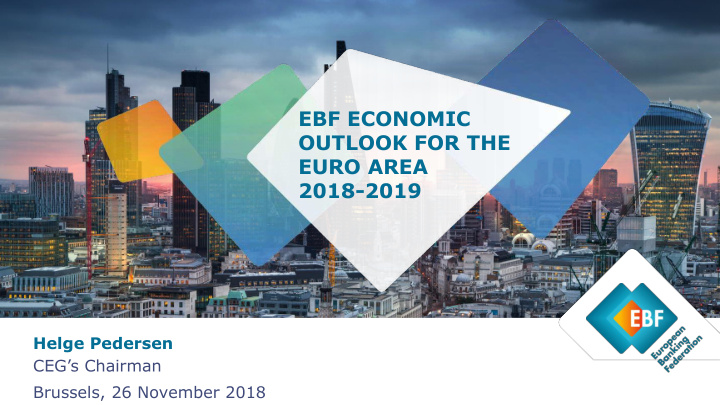



EBF ECONOMIC OUTLOOK FOR THE EURO AREA 2018-2019 Helge Pedersen CE G’s Chairman Brussels, 26 November 2018
A bi-annual report prepared with contributions from the European Banking Federation’s Chief Economists’ Group. This report reflects a consensus on the outlook for the Euro area economy, which is based on arithmetic averages.
EBF AUTUMN 2018 ECONOMIC OUTLOOK UNCERTAINTY DIMS EURO AREA GROWTH
UNCERTAINTY DIMS EURO AREA GROWTH Trade war and political uncertainty weighs on global growth • Confidence indicators are dropping from high levels • Monetary policy will get tighter but remain accomodative for growth • Risk appetite has been hit by trade disputes, inflation fear (in the USA) and political • uncertainty in Europe and the Middle East 4
European business sentiment on a soft patch 5
GDP growth is decelerating in line with ESI
Capacity utilization is well above the historic average – paving the way for new investments 7
Investment activity is rising but still below the peak in 2007-08
The strong labour market will lead to higher wage growth 9
And eventually higher inflation 10
ECB confirms plan to end stimulus programme “Based on our regular economic and monetary analyses, we decided to keep the key ECB interest rates unchanged. We continue to expect them to remain at their present levels at least through the summer of 2019, and in any case for as long as necessary to ensure the continued sustained convergence of inflation to levels that are below, but close to, 2% over the medium term.” “ Regarding non-standard monetary policy measures , we will continue to make net purchases under the asset purchase programme (APP) at the new monthly pace of €15 billion until the end of December 2018. We anticipate that, subject to incomin g data confirming our medium-term inflation outlook, we will then end net purchases. We intend to reinvest the principal payments from maturing securities purchased under the APP for an extended period of time after the end of our net asset purchases, and in any case for as long as necessary to maintain favourable liquidity conditions and an ample degree of monetary accommodation. ” Mario Draghi, Frankfurt, 25 October 2018
The oil price has collapsed. This will have an impact on inflation and act as an automatic stabiliser to growth. 12
Monetary conditions are getting tighter…
…and lending growth is likely to dampen
In spite of favourable lending rates
Economic governance has improved but a number of countries still break the rules
Has world trade entered a new paradigm? Weak demand in Europe which is a trade • intensive region Weak investment which is a trade intensive • component of expenditure have exacerbated the weakness in world trade. Chinas gradual withdrawal from GVC’s • matters. The rise of the services which is a less trade • intensive sector than manufacturing Trade/GDP ratio: 1992-2008 = 2.25; 2012- =0.75 17
A worrisome development in foreign trade 18
The CEG consensus forecast for the Euro area in 2018 and 2019 www.ebf.eu
Risks to the baseline scenario DOWNSIDE RISKS • UPSIDE RISKS • − Escalation of the fiscal conflict in Europe with clash between + Soft landing of the US economy accompanied by the European Commission and Italy -Euro area’s third biggest neutral monetary policy. economy- over Italy’s government budget plans. + Stronger than expected domestic demand growth − Worsened trade outlook with further escalation of trade if wage dynamics pick up more decisively. tensions between the US and China triggering a trade battle + Expansionary fiscal policies in some Euro area that would harm global economy. The Euro area economy, countries (which have real budgetary room for that is relatively highly exposed to external trade, would be manoeuvre), potentially bringing support to Euro severely hit if EU-US trade frictions materialise and US tariffs area economic growth. are imposed on EU sectors. + Stabilisation of global economic activity leading to − Although negotiations between the European Union and the slight acceleration of Euro area exports. United Kingdom seem to be progressing, as seen by the recent draft agreement on the withdrawal of the United + Successful political monitoring of the ‘Italian risk’ Kingdom from the European Union, the final outcome and a Brexit outcome that is economically remains a major concern. acceptable. − Further slowdown of global growth with weakened emerging economies. − Increasing geopolitical tensions having the potential to spark a period of further decline in world trade. The risks to the growth outlook are tilted to the downside, www.ebf.eu according to the Chief Economists’ Group
Thank you!
Recommend
More recommend